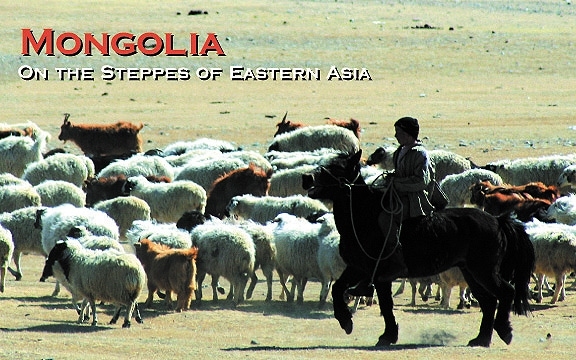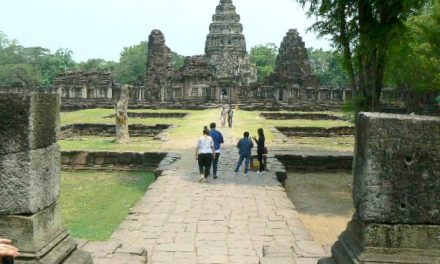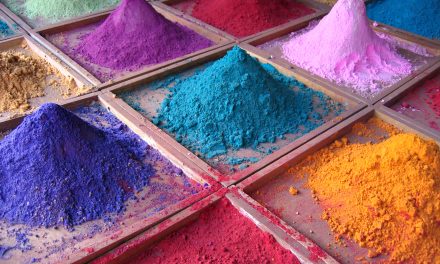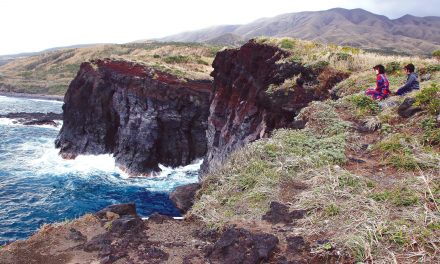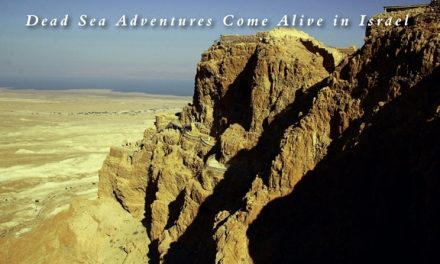Mongolia
On the Steppes of Eastern Asia
Published in the Spring 2008 Issue of Canadian World Traveller
Text and Photos by Erez Gordon (erez@mundusperegrinus.com)
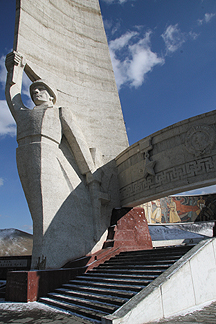 Mention Mongolia and it conjures up images of fierce warriors ranging across Asia and Eastern Europe on horseback in a dominating display of imperialism.
Mention Mongolia and it conjures up images of fierce warriors ranging across Asia and Eastern Europe on horseback in a dominating display of imperialism.
The unification of the country’s various warring tribes in the 13th century created a culture that remains easily identifiable today, despite centuries of Manchurian rule and a more recent dose of heavy-handed Soviet influence.
Geography explains much of this, since landlocked Mongolia lies between the two powerful nations of Russia to the north and China to the south.
Ulan Bataar
The capital Ulan Bataar or UB City, as locals refer to it, is a product of Mongolia’s recent dalliance with the former USSR and its own unique history. In general, the architecture consists of simple concrete buildings with little adornment, except for the odd propagandist mosaic depicting moments in Soviet history.
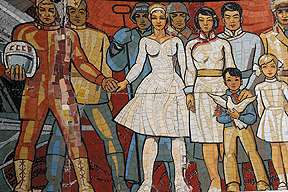 Scattered amongst these prosaic structures are traditional Mongolian nomad huts called gers, with their folding timber frames and felt walls. Able to be constructed in an hour and dismantled in half that time, gers remain a potent symbol of a persistent Mongolian culture.
Scattered amongst these prosaic structures are traditional Mongolian nomad huts called gers, with their folding timber frames and felt walls. Able to be constructed in an hour and dismantled in half that time, gers remain a potent symbol of a persistent Mongolian culture.
Mongol Empire
Genghis Kahn who was responsible for the strength and success of the Mongol Empire, created an army feared for its ferocity and admired for its horsemanship. No other mounted force could match the Mongols in skill and strategy. A visit to Mongolia must therefore include at least some horseback riding.
The tourist information centre in the centre of Ulan Bataar put me in touch with a local guide, Oyunbold, who met me at my hotel with a torrent of American English and a denim-clad swagger.
Nadaam Festival
Oyunbold is a new breed of Mongolian and a product of his country’s recent history. His English is courtesy of working with Americans stationed in Mongolia, while he credits the Russians for his general education. He also confided that he is rather good with horses, having been raised as a herder’s son and competing in the Nadaam festival as a child.
This festival is held each year on July 11, also known as Revolution Day, when Mongolia celebrates its independence from China. The day is marked by a series of horse races, each over 30 kilometres long, and only employing child jockeys.
Despite the obvious dangers and the often-resulting fatalities of both horses and jockeys, Oyunbold sighed wistfully at the memory of his youthful participation in the races.
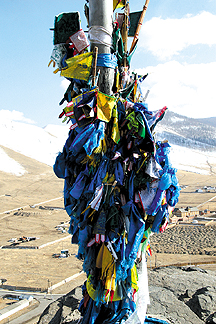 Zaisan Monument
Zaisan Monument
Our first stop before leaving UB City was at the Zaisan Monument for a small dose of Mongolian irony. The Russians constructed this highly stylized memorial to its fallen soldiers on a southern hilltop overlooking the city.
Part of the monument is a fascinating account of Soviet achievement, told in tessellation or overlapping tiles. It depicts broad-shouldered cosmonauts, grim-looking soldiers and indomitable women. More interesting is the makeshift Shamanistic shrine called an ovoo at the rear of the monument.
Mongolian Ovoos
An ovoo is a mound of stones with a timber pole at the centre to which are tied multi-coloured prayer flags. Mongolians visiting an ovoo will walk around it three times in a clockwise direction adding a rock with each circuit.
During the 1930’s, the Stalin-influenced Mongolian communist government did its best to eradicate religion by destroying hundreds of monasteries and murdering thousands of monks. As the USSR disbanded, Mongolians quickly reverted to their old ways and erected a number of these ovoos.
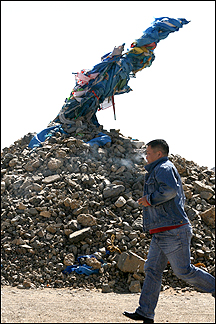 Oyunbold circled the ovoo three times praying for a safe journey and once we were back on the highway heading east out of the city, I understood why.
Oyunbold circled the ovoo three times praying for a safe journey and once we were back on the highway heading east out of the city, I understood why.
The main road was nothing short of abominable. Pot holes and cracked bitumen made driving in a straight line impossible and at times left me gasping as we swung out into oncoming traffic to avoid another chasm.
Gorkhi-Terelj National Park
Leaving the UB city limits, we drove through a brown dusty landscape only recently exposed by the melting winter snows. A half hour later we turned north and entered the Gorkhi-Terelj National Park.
Almost immediately we dropped into a valley of green pastures at the foot of conifer-covered slopes.
With the dramatic change in landscape came evidence of rural life. Clusters of gers lay in open fields, smoke rising from their chimneys. They were surrounded by small herds of livestock.
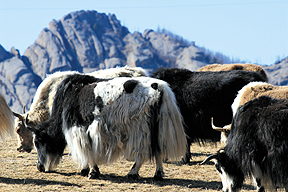 Mongolians tend sheep, goats and horses, as well as Bactrian camels, the two humped variety. A herd of shaggy-haired yaks ambled across the road, forcing us to stop.
Mongolians tend sheep, goats and horses, as well as Bactrian camels, the two humped variety. A herd of shaggy-haired yaks ambled across the road, forcing us to stop.
As we headed down a rutted, muddy track toward a collection of gers and cattle corrals, Oyunbold yelled out the car window until an old man appeared wearing a traditional del, a long coloured robe tied with a bright wide sash. A cigarette rolled from newspaper hung from his lips.
As master of the farm he would happily hire out his ponies for 3000 togrogs ($2.50 US) per hour. I was invited to wait inside his family’s ger.
Entering a Ger
Mongolia is filled with ritual and custom and being invited into a ger can be a complicated experience, as your host will take the idea of offering you hospitality quite seriously.
There are a number of things to know before stepping inside. First of all, you must enter a ger forwards and exit backwards. Secondly, while inside the ger, always move in a clockwise direction, never lean on the centre pole, never point your feet at the altar or icons and only sit where you are told to.
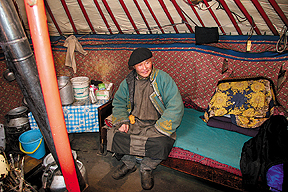 In such a small space, there is a strict demarcation between areas for men, women and visitors. Thirdly, you will be fed and you must not demur. There is no need to eat everything, but a small nibble of each item should be enough to satisfy your host.
In such a small space, there is a strict demarcation between areas for men, women and visitors. Thirdly, you will be fed and you must not demur. There is no need to eat everything, but a small nibble of each item should be enough to satisfy your host.
Tea & Biscuits
I was shown to a low stool. The old man sat on his bed with arms akimbo, reminding me of Yul Brynner in ‘The King and I’, while his wife presented me with some boortsog and Mongolian milk tea.
Boortsog is a dense flour biscuit cut into various geometric shapes and fried in the fat remaining in the pan from cooking meats. It was easy to imagine how a diet of boortsog might see you through a Mongolian winter, when the temperature falls below -40 Celsius.
To wash this down, Mongolian milk tea, Suutei Tsai, is served in tin bowls. This is made with brick tea and cow’s milk. Salt is added, as well as a dollop of butter to enrich the flavour.
Also on the table was a semi-hard curd cheese made from ‘first milk’. This air-dried cheese uses the first milk of a cow that has recently calved.
The ger was warm inside thanks to a central wood-fired stove and decorated with a mixture of the old and new world artefacts. It was obvious that living in a portable felt hut did not require going without the convenience of a television or microwave oven.
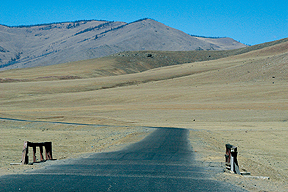 Riding through the Steppes
Riding through the Steppes
The old man’s son Miga arrived with the horses and I prudently confessed my inexperience. A quick conversation in Mongolian followed and it was agreed that Miga would accompany me at an extra cost. I happily agreed.
I needn’t have worried. During the entire time, my pony barely rose to more than a trot. Actually, riding through the Mongolian countryside at walking pace allowed me to absorb the cinematic scope of my surroundings.
Miga and I rode through bare-branched woods along dried riverbeds filled with worn boulders. Flat white sheets of the past winter’s ice and snow still covered the banks.
We ambled past resting cattle, ger farms and out onto a grassy plain in a wide valley set between snow-capped peaks.
On the horizon, a dray pulled by a team of four galloping horses passed by. For the rest of the time, the only sounds I heard were the steady hoof-falls of our ponies and the regular sharp ‘choo’ sounds Miga made to goad them along.
A Proud History
For two hours astride my swaying saddle, I felt the Mongolian terrain rise and fall beneath me. I sensed the power of the landscape and marvelled at how the steppes of Eastern Asia remain to this day the cherished home of a nomadic people living harmoniously with such extreme physical and climatic conditions.
To ride a horse in Mongolia is to delve a little deeper into the true Mongol nature and I highly recommend it. Mongolians may have rushed headlong into the 21st century but they have defiantly brought their proud history and unique culture along for the ride.
For More About Mongolia
Mongolia Tourism
Websites: www.mongoliatourism.gov.mn and
www.travelmongolia.org

